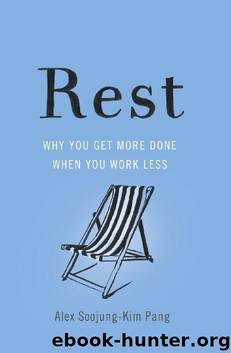Rest: Why You Get More Done When You Work Less by Alex Soojung-Kim Pang

Author:Alex Soojung-Kim Pang [Pang, Alex Soojung-Kim]
Language: eng
Format: epub, mobi
ISBN: 9780241974346
Publisher: Penguin Books Ltd
Published: 2016-12-05T18:30:00+00:00
Exercise
I hope that … the ideal of the well-trained and vigorous body will be maintained neck by neck with that of the well-trained and vigorous mind, as the two coequal halves of the higher education, for men and women alike.
—WILLIAM JAMES
In the late 1950s, UCLA sociologist Bernice Eiduson wanted to understand what separates great scientists from their less-accomplished colleagues. Lots of psychologists had tried to figure out what marked some people for greatness, but no one had found the thing—the single personality trait, the “genius gene,” the cognitive edge—that all successful scientists share. Eiduson thought that by watching their careers unfold over several decades and talking to and testing them at regular intervals, she might see things in successful lives that couldn’t be identified through one-off interviews and short studies. Eiduson found forty young and mid-career scientists at UCLA, Caltech, and elsewhere who agreed to be interviewed about their life and work, sit for psychological tests, and, most crucially, keep doing so. All of them were products of top graduate programs, promising researchers, and young enough to look forward to long, productive careers.
Eiduson followed this group for more than twenty years, and in that time the paths of the forty diverged. Some were elected to the prestigious National Academy of Sciences and received promotions and prestigious chairs at their universities. One became a presidential science advisor. Four won the Nobel Prize; one, Linus Pauling, won two. Others, in contrast, settled into less-distinguished careers. Some continued to struggle to do serious science but couldn’t keep up. They became administrators or focused on teaching.
From a sociological standpoint, it was an ideal outcome. A group that looked roughly the same decades earlier had split into two parts. The challenge now was to figure out why.
The psychological profiles in Eiduson’s group were maddeningly diverse. Their intelligence tests didn’t routinely reveal inborn genius. There were some personality traits that good scientists shared—they had a high tolerance for uncertainty and lots of self-control, saw themselves as intellectual rebels, and maintained strong boundaries between home and work—but these traits aren’t exactly rare. After Eiduson died in 1985, her longtime UCLA collaborator Maurine Bernstein kept the study going, joined by her son, Robert Scott Root-Bernstein, and statistician Helen Garnier. The three added some new questions to the interviews. They started asking the scientists whether they played sports or spent time outdoors. They asked about their hobbies and artistic interests. They asked how nonscientific activities connected or competed with each other. They asked how they managed their time and how pressed for time they felt.
The new questions revealed something interesting. The best scientists showed “an unusual urge to experiment athletically as well as scientifically” and selected “athletic activities that could be carried from youth into old age.” Los Angeles conjures images of endless urban sprawl, but in fact the area is surrounded by hills and national parks, and thanks to its mild climate you can spend time outdoors most of the year. The top scientists took full advantage of the region’s geography: they played tennis and went swimming, hiking, and skiing.
Download
Rest: Why You Get More Done When You Work Less by Alex Soojung-Kim Pang.mobi
This site does not store any files on its server. We only index and link to content provided by other sites. Please contact the content providers to delete copyright contents if any and email us, we'll remove relevant links or contents immediately.
Periodization Training for Sports by Tudor Bompa(8211)
Bodyweight Strength Training by Jay Cardiello(7877)
Born to Run: by Christopher McDougall(7090)
Inner Engineering: A Yogi's Guide to Joy by Sadhguru(6752)
Asking the Right Questions: A Guide to Critical Thinking by M. Neil Browne & Stuart M. Keeley(5708)
The Fat Loss Plan by Joe Wicks(4876)
Bodyweight Strength Training Anatomy by Bret Contreras(4645)
Yoga Anatomy by Kaminoff Leslie(4333)
Dynamic Alignment Through Imagery by Eric Franklin(4176)
Science and Development of Muscle Hypertrophy by Brad Schoenfeld(4103)
Exercise Technique Manual for Resistance Training by National Strength & Conditioning Association(4020)
ACSM's Complete Guide to Fitness & Health by ACSM(4019)
The Four-Pack Revolution by Chael Sonnen & Ryan Parsons(3945)
Bodyweight Strength Training: 12 Weeks to Build Muscle and Burn Fat by Jay Cardiello(3940)
The Ultimate Bodybuilding Cookbook by Kendall Lou Schmidt(3906)
Yoga Anatomy by Leslie Kaminoff & Amy Matthews(3880)
American Kingpin by Nick Bilton(3819)
Nutrition for Sport, Exercise, and Health by Spano Marie & Kruskall Laura & Thomas D. Travis(3742)
Yoga Therapy by Mark Stephens(3721)
